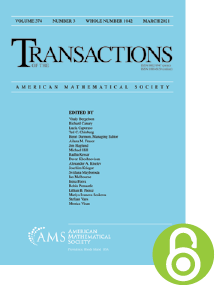Balanced rings and a problem of Thrall
HTML articles powered by AMS MathViewer
- by Victor P. Camillo PDF
- Trans. Amer. Math. Soc. 149 (1970), 143-153 Request permission
Abstract:
Balanced ring is defined and related to Thrall’s QF-1 rings. Several theorems are obtained which show that balanced rings enjoy strong homological and chain conditions. The structure of commutative balanced rings is determined. Also, the structure of commutative artinian QF-1 rings is gotten. This is a generalization of a theorem of Floyd.References
- Hyman Bass, Finitistic dimension and a homological generalization of semi-primary rings, Trans. Amer. Math. Soc. 95 (1960), 466–488. MR 157984, DOI 10.1090/S0002-9947-1960-0157984-8
- K. Feĭs, Algebra: kol′tsa, moduli i kategorii. II, “Mir”, Moscow, 1979 (Russian). Translated from the English by L. A. Koĭfman, A. V. Mikhalev, T. S. Tol′skaya, G. M. Tsukerman and M. P. Dorofeeva; Edited by L. A. Skornjakov. MR 551052
- Carl Faith, A general Wedderburn theorem, Bull. Amer. Math. Soc. 73 (1967), 65–67. MR 202763, DOI 10.1090/S0002-9904-1967-11642-2
- Carl Faith, Lectures on injective modules and quotient rings, Lecture Notes in Mathematics, No. 49, Springer-Verlag, Berlin-New York, 1967. MR 0227206
- Denis Ragan Floyd, On $\textrm {QF}-1$ algebras, Pacific J. Math. 27 (1968), 81–94. MR 234988
- Kent R. Fuller, Double centralizers of injectives and projectives over artinian rings, Illinois J. Math. 14 (1970), 658–664. MR 268217
- Kent R. Fuller, Generalized uniserial rings and their Kupisch series, Math. Z. 106 (1968), 248–260. MR 232795, DOI 10.1007/BF01110273
- Joachim Lambek, Lectures on rings and modules, Blaisdell Publishing Co. [Ginn and Co.], Waltham, Mass.-Toronto, Ont.-London, 1966. With an appendix by Ian G. Connell. MR 0206032
- Kiiti Morita, On algebras for which every faithful representation is its own second commutator, Math. Z. 69 (1958), 429–434. MR 126492, DOI 10.1007/BF01187420
- Kiiti Morita, Duality for modules and its applications to the theory of rings with minimum condition, Sci. Rep. Tokyo Kyoiku Daigaku Sect. A 6 (1958), 83–142. MR 96700 A. Ornstein, Ph.D. Thesis, Rutgers University, New Brunswick, N.J., 1966.
- B. L. Osofsky, A generalization of quasi-Frobenius rings, J. Algebra 4 (1966), 373–387. MR 204463, DOI 10.1016/0021-8693(66)90028-7
- R. M. Thrall, Some generalization of quasi-Frobenius algebras, Trans. Amer. Math. Soc. 64 (1948), 173–183. MR 26048, DOI 10.1090/S0002-9947-1948-0026048-0
- Yuzo Utumi, Self-injective rings, J. Algebra 6 (1967), 56–64. MR 209321, DOI 10.1016/0021-8693(67)90013-0
- J. P. Jans, Note on $\textrm {QF}$-$1$ algebras, Proc. Amer. Math. Soc. 20 (1969), 225–228. MR 233848, DOI 10.1090/S0002-9939-1969-0233848-X S. E. Dickson and K. R. Fuller, Commutative artinian QF-1 rings are QF, (to appear).
Additional Information
- © Copyright 1970 American Mathematical Society
- Journal: Trans. Amer. Math. Soc. 149 (1970), 143-153
- MSC: Primary 16.50
- DOI: https://doi.org/10.1090/S0002-9947-1970-0260794-0
- MathSciNet review: 0260794


